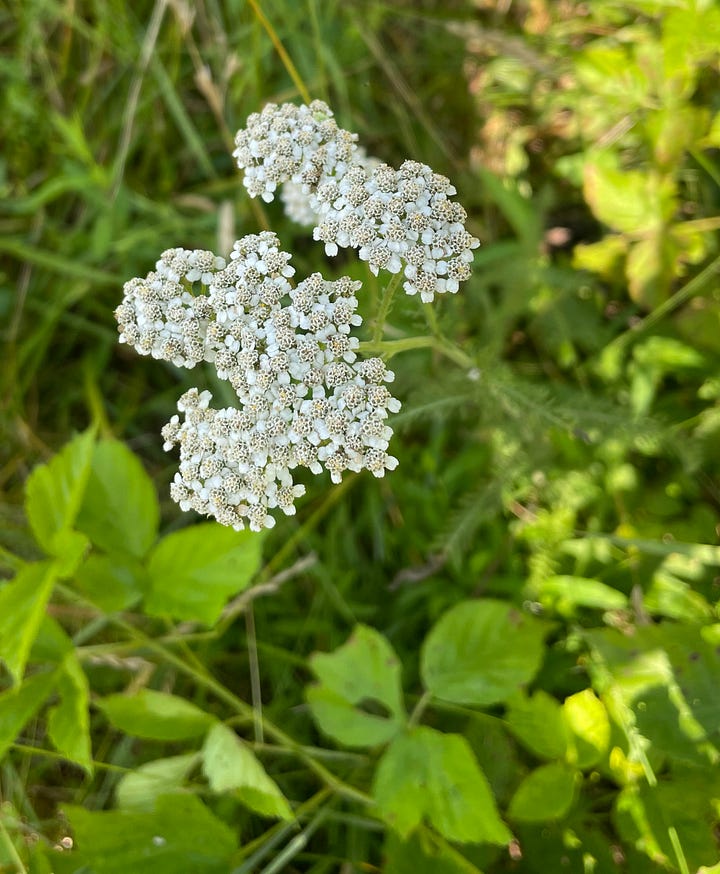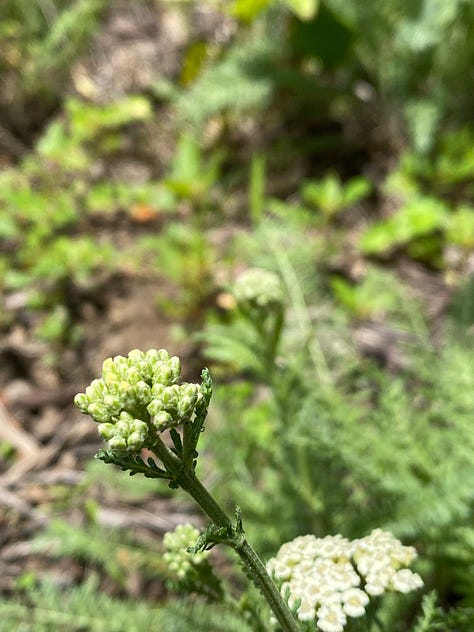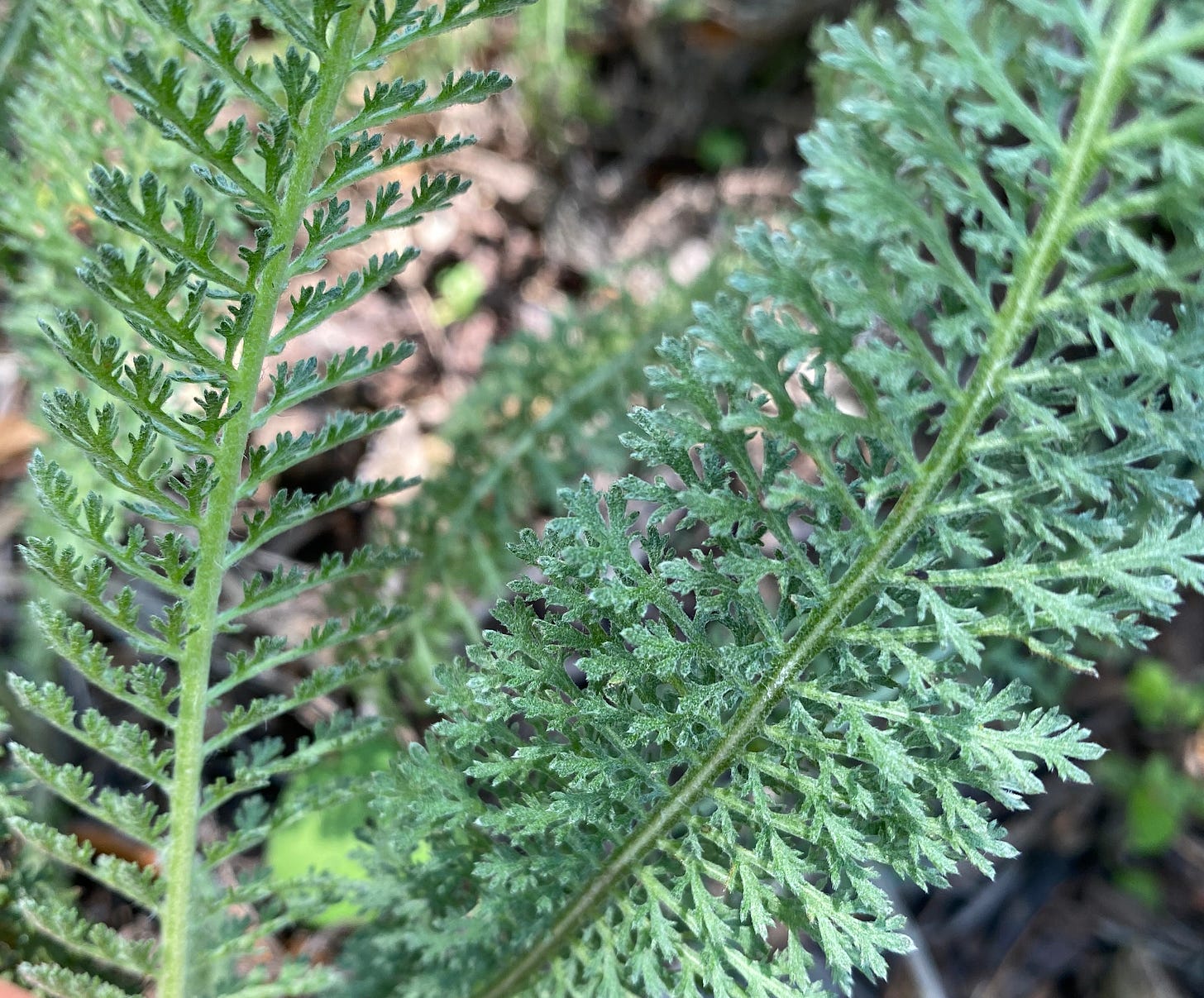The feathery leaves of yarrow have been likened to squirrels tail (Chippewa), to centipedes (China), or to kitten tails (Hungary). Tiny hairs on the triply divided leaves contribute to the softness. This perennial rosette of feathers sometimes lasts through the winter, but often dies back to reemerge from the roots each spring. Some claim evidence of neanderthals utilizing this weed, and written records assure us that the medicinal use extends to ancient times as a vulnerary, hemostatic for treatment of battlefield wounds. Achillea millefolium is long established medicinally in the western world, also as cooling, astringent, to treat acute fevers, and some bronchial issues, and ‘stagnant blood’. The Chinese made use of the related Achillea sibirica, a.k.a. i-chi-kao, as a stomach tonic, anti-inflammatory, for abdominal cramps, abcesses, snakebites, traumatic injury and bleeding. You’ll hear some call this an edible weed, but that is in spice quantities rather than food quantities, due to the potent plant chemistry. It was used to flavor beer, which added an extra punch, somewhere between chamomile and absinthe in the ability to produce sleepiness, vivid dreams, or hallucinations. Yarrow is used as a part of digestive bitter formulations. The aromatic smell is attractive, a bit like ground ivy, or wormwood, but with a bit of the sweetness of chamomile.
Our wild yarrow, which occupies hilly territory at weedom is struggling a bit during this dry 2023. We will not be harvesting from that growth unless things improve drastically.


For better visibility, our lower pics feature the yarrow which has been spreading through the landscape for several years. Though many herbalists recommend the wild yarrow only, we find that our cultivated yarrow retains styptic activity to stop bleeding, and the roots have the characteristic anesthetic properties, useful for toothache and sore throat. Some herbalists purport that the variability of plant chemistry among strains of Achillia millefolium has a lot to do with climate and soil conditions, with the yarrow grown in poor or gravelly soil said to be more potent. We’ll be depending on our landscape yarrow this year, which was first planted as a pink floral form, but has since produced some yellow and some white / cream flowered progeny. Even with adequate rainfall, our wild yarrow has thinner, more trailing leaves, and thinner flowering stems than the cultivar that dominates our landscape. Wild yarrow in our area is a creamy white, though pinkish tinged flowers occur in some areas.



Some worry that people might have trouble distinguishing yarrow from some poisonous plants such as poison hemlock. Not a chance after today. Though both leaves are triply cut, the size and the feeling of the leaves are entirely different. Poison hemlock is hairless, and smells a bit nasty, like mouse urine when you crush it. The much smaller yarrow has tiny hairs on the entirely green stems and on the leaves which impart a soft feeling. Think feathers, or kitten tails when looking for yarrow, and there’s no way you’ll chew on even a first year poison hemlock.
Yarrow, Achillea millefolium, of the family Asteraceae, has the characteristic (4 or 5) ray and disk flowers, but they’re tiny, about 3 millimeters in diameter and arranged in an flat topped umbrella or corymb. Underneath a corymb, you can see that the flower stems (pedicels) arise from different heights on the stem, but end at the same height, creating the flat topped look. If you click and enlarge the right most gallery photo, above, you might see this more clearly.
Leaves are compound, and bi-pinnately arranged, with the smallest leaflets also deeply cut, and showing palmate venation. Tiny hairs are most apparent on the upper side of the leaf, and on the stems, but they are more easily felt than visualized, and contribute to the characteristic soft feeling of the plant. The leaves arise as a rosette, which later sends up a flowering stem with smaller, alternately arranged leaves. Under favorable conditions, the stem of wild yarrow might reach a height close to a meter, 3 feet. In our area, (Northmost zone 6 of Midwest U.S.) this weed dies back with the frost, but will arise each year from the base as a good perennial should. It spreads both by seed and by underground rhizomes. Below is a look at one of those rhizomes from which a tiny plant emerged outside the edge of landscape. Herbalists report that the thinner, true roots have more medicinal activity than the rhizomes, and prefer to tincture those. Chewing the rhizome shown below, however, did elicit some topical anesthetic activity: a numb tongue.
Achillea millefolium is polymorphous and variably polyploid, with chromosome counts ranging from diploid to octaploid. These forms have the ability to mix and recombine, causing the botanists to throw up their hands in despair at the prospect of never splitting them into different species. (It’s the worst for one’s graduate thesis to become feces even before getting the work published.) Reliably distinguishing species within this genus has been impossible, and so has solidly characterizing them from a medicinal standpoint. Numerous useful compounds from these plants have been elucidated, including alkaloids, terpenes, flavonoids and other polyphenols of known benefit. Over 80 constituents have been found in the essential oils, which have been extracted in ~ 1% yield from Achillea millefolium. Components of the essential oils of these weeds vary widely based even more upon where the plant material is sourced, than the manner of extraction. A study by Falconieri et al, investigated Achillea millefolium essential oil activity against yeast, dermatophyte and aspergillus types of fungi. Their plant samples from Portugal produced essential oil containing mostly trans-thujone , trans-crhysanthenyl acetate and β-pinene, while the plants from Italy showed predominantly α-asarone, β-bisabolene and α-pinene. Surprisingly, the spectra of antifungal activities of the plants were largely similar, suggesting that perhaps minor components, such as germacrene-D, which were present in similar amounts, accounted for the antifungal activity. Chamazulene, an amazingly active product from yarrow can vary widely as a percentage of the essential oil. This blue compound is formed from matricin during hydro-distillation, and has been observed in extractions of yarrow, chamomile and wormwood. Chamazulene is known for inhibiting leukotriene B4 production in neutrophilic granulocytes, as well as inhibiting tumor necrosis factor-α and interleukin-6, which could account for some of the anti-inflammatory activity exhibited by these plant extracts. It perhaps contributed to the anti-inflammatory effects observed in a mouse model of ulcerative colitis. It’s exciting to imagine that weeds could produce an effective treatment for that nasty disease. Don’t tell folks at the FDA :-D Chamazulene and the related precursors matricin, achillicin and achillin, found variably in yarrow, all contribute to antibacterial, anti-inflammatory and vulnerary (wound healing) properties for which this plant is sought. You’ll hear more about these molecules if you hang around weedom for awhile. They’re important. Also keep in mind thujone (which can make you see things that aren’t there). This compound definitely puts a limit on how much of a weed you can have, and whether pregnant women should shy away from it.

Yarrow is yet another herb credited with conflicting activities. It has been said to both thin the blood and to stop bleeding. Part of this might be due to assumptions that all the coumarin related compounds do what dicoumerol does to inhibit coagulation. They don’t. But the furanocoumarins in yarrow can cause photosensitivity in some people, and in sufficient quantity, they slow the metabolism of certain drugs in the liver. The smooth muscle relaxant, vasodilatory action of yarrow also seems to somewhat oppose its ability to quickly stop bleeding. Achilleine is the constituent which is said to be responsible for inhibiting bleeding in animals and humans. It’s a small and highly water soluble molecule characterized in 1953 as an alkaloid derivative. It was said to be less soluble in ethanol and insoluble in more polar solvents. There remains surprisingly little known about this small molecule despite it being credited with such a useful and prominent effect. Quite a lot of confusion exists among those who have made claims about its identity and structure. Vasodilatory molecules, achillin and leucodin were extracted from flowers and found in very non-polar hexane fractions, and are thought to support the traditional anti-hypertensive use of yarrow. One of yarrow’s flavonoid compounds, artemetin has been shown to affect production of angiotensin, as a further contribution to lowering blood pressure.
Particularly when you’re depending on the essential oil constituents for medicine, you will have to learn about your own yarrow. It doesn’t suffice to assume that “wild yarrow is better than cultivated strains of yarrow”. Get to know your own stash. Plant some roots from the crop that does what you like. Compare the flavors to its relatives, wormwood, pineapple weed, or chamomiles of the German and Roman species. Also compare your yarrow to the aromatic herbs and spices in your collection. If you live in a hot place, perhaps look at the Indian studies of yarrow essential oils, and if you live in a cool place, look at some from Europe. :-D Though they’re pretty cost effective, we all can’t have a gas chromatograph in the house. The smell and taste of our weeds can give a general idea about what kind of medicinal benefits they might have, and when they have lost potency. Just be ready to spit some of them back out.
Thanks for hanging around weedom. Have you harvested some Yarrow? What are you going to do with it? Leave a comment or flag us down in Notes if you have pictures.
Where we dig
1. Yarrow: The Healing Herb of Achilles |. Accessed July 12, 2023. https://sites.evergreen.edu/plantchemeco/yarrow-the-healing-herb-of-achilles/
2. https://www.facebook.com/Drugscom. Yarrow Uses, Benefits & Dosage - Drugs.com Herbal Database. Drugs.com. Accessed July 10, 2023. https://www.drugs.com/npp/yarrow.html
3. Yarrow root tincture / mouthwash for dental antibiotic & pain relief: how to make it, with pictures (medicinal herbs forum at permies). Accessed July 11, 2023. https://permies.com/t/115101/Yarrow-root-tincture-mouthwash-dental
4. Mohamed ME, Elsayed SA, Madkor HR, Eldien HMS, Mohafez OM. Yarrow oil ameliorates ulcerative colitis in mice model via regulating the NF-κB and PPAR-γ pathways. Intest Res. 2020;19(2):194-205. doi:10.5217/ir.2020.00021
5. Applequist W, Moerman D. Yarrow (Achillea millefolium L.): A Neglected Panacea? A Review of Ethnobotany, Bioactivity, and Biomedical Research1. Economic Botany. 2011;65:209-225. doi:10.1007/s12231-011-9154-3
6. Radusiene J, Karpaviciene B, Raudone L, et al. Trends in Phenolic Profiles of Achillea millefolium from Different Geographical Gradients. Plants. 2023;12:746. doi:10.3390/plants12040746
7. Easley T. The Modern Herbal Dispensatory - a Medicine-Making Guide.; 2016. https://openlibrary.org/books/OL26933940M/The_modern_herbal_dispensatory
8. DerMarderosian A, Buetler J. Review of Natural Products. 8th edition. Lippincott Williams & Wilkins; Facts and Comparisons; 2014. https://openlibrary.org/books/OL27960482M/Review_of_Natural_Products
9. (PDF) The Essential Oil Composition of Achillea millefolium L. Cultivated under Tropical Condition in India. Accessed July 12, 2023. https://www.researchgate.net/publication/233934084_The_Essential_Oil_Composition_of_Achillea_millefolium_LCultivated_under_Tropical_Condition_in_India
10. Grieve M. Modern Herbal. Echo Point Books & Media, LLC.; 2015. https://openlibrary.org/books/OL36722889M/Modern_Herbal
11. Hutchens AR. Indian Herbalogy of North America. Shambhala; Distributed in the United States by Random House; 1991. https://openlibrary.org/books/OL1567124M/Indian_herbalogy_of_North_America
12. de Souza P, Gasparotto A, Crestani S, et al. Hypotensive mechanism of the extracts and artemetin isolated from Achillea millefolium L. (Asteraceae) in rats. Phytomedicine. 2011;18(10):819-825. doi:10.1016/j.phymed.2011.02.005
13. Ganora L. Herbal Constituents, 2nd Edition - Foundations of Phytochemistry. Lulu Press, Inc.; 2021. https://openlibrary.org/books/OL35083771M/Herbal_Constituents_2nd_Edition
14. Wang X, Dong K, Ma Y, Jin Q, Yin S, Wang S. Hepatoprotective effects of chamazulene against alcohol-induced liver damage by alleviation of oxidative stress in rat models. Open Life Sci. 2020;15(1):251-258. doi:10.1515/biol-2020-0026
15. Dias MI, Barros L, Dueñas M, et al. Chemical composition of wild and commercial Achillea millefolium L. and bioactivity of the methanolic extract, infusion and decoction. Food Chem. 2013;141(4):4152-4160. doi:10.1016/j.foodchem.2013.07.018
16. Falconieri D, Piras A, Porcedda S, et al. Chemical Composition and Biological Activity of the Volatile Extracts of Achillea millefolium. Natural Product Communications. 2011;6(10):1934578X1100601030. doi:10.1177/1934578X1100601030
17. Safayhi H, Sabieraj J, Sailer ER, Ammon HP. Chamazulene: an antioxidant-type inhibitor of leukotriene B4 formation. Planta Med. 1994;60(5):410-413. doi:10.1055/s-2006-959520
18. Pires JM, Mendes FR, Negri G, Duarte-Almeida JM, Carlini EA. Antinociceptive peripheral effect of Achillea millefolium L. and Artemisia vulgaris L.: both plants known popularly by brand names of analgesic drugs. Phytotherapy Research. 2009;23(2):212-219. doi:10.1002/ptr.2589
19. Arias-Durán L, Estrada-Soto S, Hernández-Morales M, et al. Antihypertensive and vasorelaxant effect of leucodin and achillin isolated from Achillea millefolium through calcium channel blockade and NO production: In vivo, functional ex vivo and in silico studies. J Ethnopharmacol. 2021;273:113948. doi:10.1016/j.jep.2021.113948
20. Landers RM. AN IMPROVED ISOLATION METHOD FOR ACHILLEINE, AN ALKALOID FROM ACHILLEA MILLEFOLIUM LINNE.
21. Miller FM, Chow LM. Alkaloids of Achillea millefolium L. I. Isolation and Characterization of Achilleine1,2. J Am Chem Soc. 1954;76(5):1353-1354. doi:10.1021/ja01634a048
22. Alomair MK, Alabduladheem LS, Almajed MA, et al. Achillea millefolium Essential Oil Mitigates Peptic Ulcer in Rats through Nrf2/HO-1 Pathway. Molecules. 2022;27(22):7908. doi:10.3390/molecules27227908
23. Achillea millefolium (yarrow) | CABI Compendium. Accessed July 11, 2023. https://www.cabidigitallibrary.org/doi/10.1079/cabicompendium.2636
24. Achillea millefolium (PROSEA) - PlantUse English. Accessed July 12, 2023. https://uses.plantnet-project.org/e/index.php?title=Achillea_millefolium_(PROSEA)&mobileaction=toggle_view_desktop
25. Achillea millefolium (Common Yarrow, Devil’s Nettle, Dog Daisy, Dog Fennel, Milfoil, Soldier’s Woundwort, Thousandleaf, Westen Yarrow, Yarrow) | North Carolina Extension Gardener Plant Toolbox. Accessed July 11, 2023. https://plants.ces.ncsu.edu/plants/achillea-millefolium/
26. Saeidnia S, Gohari AR, Mokhber-Dezfuli N, Kiuchi F. A review on phytochemistry and medicinal properties of the genus Achillea. Daru. 2011;19(3):173-186.
27. Hunan Zhong yi yao yan jiu suo, ed. A Barefoot Doctor’s Manual. Rev. & enl. ed. Cloudburst Press ; distributed to the trade in the U.S.A. by S. Greene Press; 1977.








I use it medicinally, but a friend in Austria recommended yarrow as a culinary herb, fresh. It is pretty good - kind of slightly bitter, calamus flavor, kind of peppery. It is actually very good in salads or with fish
Thank you for this wonderful info!! I've yet to find yarrow in the wild myself, but am ready to now!